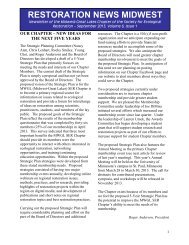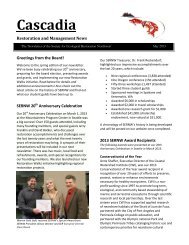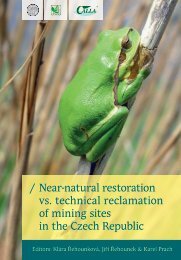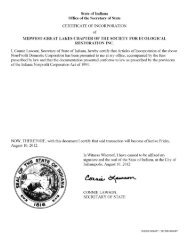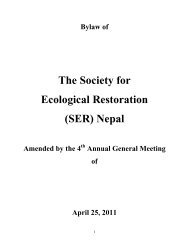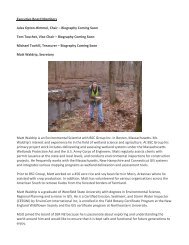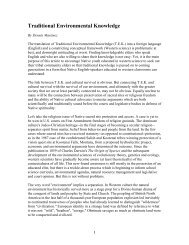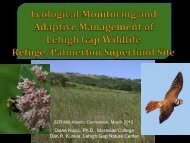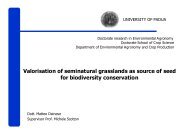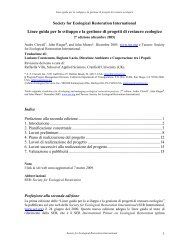THE WORLD CONFERENCE ON ECOLOGICAL RESTORATION
A Global Challenge - Society for Ecological Restoration
A Global Challenge - Society for Ecological Restoration
You also want an ePaper? Increase the reach of your titles
YUMPU automatically turns print PDFs into web optimized ePapers that Google loves.
2005 The World Conference on Ecological Restoration 23<br />
Implications of rural-urban migration for forest restoration in Latin America<br />
Aide 1 T.M., H.R. Grau 2<br />
1 Department of Biology, University of Puerto Rico, San Juan, Puerto Rico<br />
2 LIEY, Universidad Nacional de Tucumán, Tucumán, Argentina<br />
Rural-urban migration is one of the most important current demographic processes, in particular, in<br />
countries undergoing socioeconomic changes associated with globalization. In most regions, the lands<br />
that are being abandoned are in the mountains, in areas with steep slopes. These areas play a major role<br />
in determining watershed regimes including floods and the seasonality of water flow. The increase in vegetation<br />
cover by natural regeneration or restoration will help reduce erosion and floods, and at the same<br />
time provide habitat for many organisms. Given that demographic and socioeconomic changes appear to<br />
be as important as conservation efforts, we need to make a stronger effort to understand and incorporate<br />
these processes into forest management and conservation activities.<br />
Keywords: natural regeneration, abandoned agricultural lands, montane forest.<br />
Impact of long term application of wastewater on soil microbial biomass C and N<br />
and accumulation of bacteria of fecal origin<br />
Al-rashidi R., M. Rusan<br />
Land Management and Environment Department, College of Natural resources and Environment, Hashemite university,<br />
13115 Zarqa, Jordan<br />
In most countries of the Mediterranean region such as Jordan, there is an increasing and an urgent need<br />
to conserve and protect water resources. Water is a vital resource but a severely limited one in these countries.<br />
Consequently, the reuse of wastewater for agriculture is highly encouraged. The objectives of this<br />
study were to evaluate the cycling of C and N within the system through the determination of microbial<br />
biomass C and N and the health hazard that may associated with the using and handling of wastewater.<br />
Soil samples were taken from different sites from the Ramtha wastewater treatment plant. Sites that have<br />
been irrigated with wastewater for the last 17, 10, 4, and 1 years were identified and used as the sampling<br />
sites for this study. In addition, another two sites that have not been irrigated with wastewater were sampled<br />
as a control. From each location, soil samples were taken from several sites within each location, and<br />
at the following depths: 0-20, 20-40, and 20-60 cm. Microbial biomass was determined using chloroform<br />
fumigation technique and found to increase with increasing period of wastewater application. Results<br />
showed that microbial biomass as C was a lot higher than the microbial biomass as N. The bacteriological<br />
analysis showed that the total aerobic bacterial count of surface soil ( 0-20 cm) were higher in sites irrigated<br />
with wastewater for the last 10 and 17 years, suggesting that the use of this wastewater stimulate these<br />
microflora.The total coliforms ranged from 0.92x10 2 CFU/g to 17.0x10 2 CFU/g, while fecal coliform were<br />
less and only detected in sites irrigated with wastewater for the last 10 and 17 years.<br />
Keywords: Wastewater. Biomass. Coliforms.<br />
What is Forest Landscape Restoration? Some experiences and lessons learned<br />
from WWF's global portfolio of initiatives<br />
Aldrich M.<br />
Forest for Life Programme. WWF International. Avenue du Mont Blanc. 1196 Gland. Switzerland<br />
In response to the challenges of the continuing loss of forest cover and quality, with associated development<br />
as well as environmental problems in many parts of the world, WWF, working in collaboration with<br />
IUCN and other partners, has adopted a “Forest Landscape Restoration” approach, which is defined as “a<br />
process that aims to regain ecological integrity and enhance human wellbeing in deforested or degraded<br />
forest landscapes”. The concept of FLR is not a new idea. It builds on a number of existing rural development,<br />
conservation and natural resources management principles and approaches, bringing them together<br />
to restore multiple forest functions to degraded landscapes. WWF’s Forests for Life Programme is<br />
actively developing a learning portfolio of FLR initiatives in a number of countries and regions including<br />
the Mediterranean, East Africa and Madagascar, Atlantic Forests of Argentina and Brazil, New Caledonia,<br />
China and Indonesia. Although most of these initiatives are relatively young in terms of a restoration<br />
timescale, a number of interesting and useful lessons and experiences are starting to emerge related to<br />
planning, development and implementation. These include the need for a full and representative multistakeholder<br />
planning process, clear goals – both biodiversity and socio-economic and simple tools for<br />
tracking changes at the landscape level. Further aspects of work which warrant more focus include the<br />
role of FLR in carbon sequestration within the Clean Development Mechanism, and as a tool for engaging



